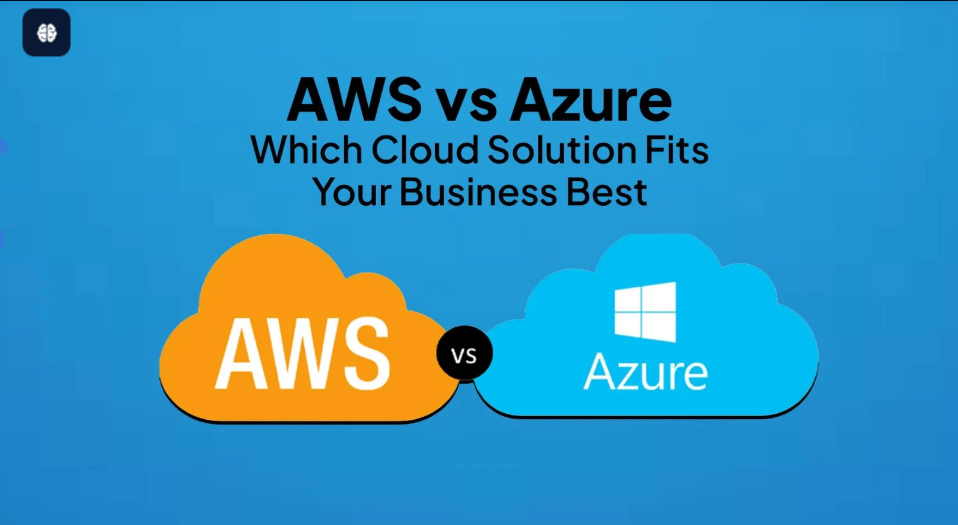In the age of digital transformation, choosing the right cloud partner can make or break your business’s success. Cloud computing is no longer a luxury — it’s a necessity for scalability, agility, and innovation. Among the leading cloud providers, Amazon Web Services (AWS) and Microsoft Azure have emerged as the most dominant and reliable platforms. However, deciding which one fits your unique business needs can be a complex choice. This comprehensive guide breaks down the key differences between AWS vs Azure, helping you choose the best cloud partner for your business in 2025.
Understanding AWS and Azure
Amazon Web Services (AWS) was launched in 2006 and quickly became the pioneer in cloud computing. It provides a wide range of cloud solutions, including computing power, database storage, content delivery, and machine learning tools. AWS dominates the cloud market due to its innovation, reliability, and extensive global network.
Microsoft Azure, introduced in 2010, has rapidly grown to compete head-to-head with AWS. With its deep integration into Microsoft products like Office 365, Windows Server, and Active Directory, Azure is often the first choice for enterprises already rooted in the Microsoft ecosystem. It is known for its hybrid capabilities, enterprise-grade security, and compliance standards.
Service Range and Functionality
Both AWS and Azure provide an extensive array of cloud services that cater to different industries, but their offerings differ in certain ways.
AWS Services:
AWS offers more than 200 fully developed cloud services. The key components include:
- Amazon EC2 – Virtual servers for scalable computing.
- Amazon S3 – Object storage for data backup and archiving.
- Amazon RDS – Managed database services.
- AWS Lambda – Serverless computing for running code without managing servers.
AWS is highly flexible and supports a broad variety of development environments, making it ideal for organizations that need scalability and customization.
Azure Services:
Azure matches AWS with its own powerful services:
- Azure Virtual Machines – Scalable compute resources for applications.
- Azure Blob Storage – Object storage for unstructured data.
- Azure SQL Database – Fully managed relational database.
- Azure Functions – Serverless computing for automation and workflows.
Azure’s main advantage lies in its seamless integration with Microsoft software and its strong support for hybrid cloud environments, allowing businesses to run workloads both on-premises and in the cloud.
Performance and Global Reach
Global availability is one of the most critical factors when selecting a cloud partner.
AWS Global Reach:
AWS operates in over 30 regions and more than 100 availability zones, offering extensive coverage across North America, Europe, Asia, and beyond. Its massive network ensures high performance, low latency, and dependable uptime — ideal for businesses with global operations.
Azure Global Reach:
Azure serves more than 60 regions worldwide, giving it the broadest geographic reach of any cloud provider. This makes Azure highly compliant with data residency laws and local regulations, a key factor for industries like healthcare, finance, and government.
When comparing the two, AWS leads in maturity and uptime reliability, while Azure excels in regional presence and regulatory compliance.
Pricing and Cost Comparison
Cloud pricing can be one of the most confusing aspects when selecting a provider. Both AWS and Azure use a pay-as-you-go model, where you pay only for the resources you consume.
AWS Pricing:
AWS provides several pricing models, including On-Demand Instances, Reserved Instances, and Savings Plans. While it offers transparent pricing tools, costs can add up quickly without careful management. However, its flexibility and variety of cost-saving options make it ideal for businesses with dynamic workloads.
Azure Pricing:
Azure is often considered more cost-effective for companies already using Microsoft products. Through the Azure Hybrid Benefit, businesses can use their existing Windows Server and SQL Server licenses to reduce cloud costs significantly. Azure also offers predictable billing for enterprise customers, making budgeting easier.
In general, AWS offers broader flexibility, while Azure provides better long-term savings for Microsoft-based businesses.
Security and Compliance
Security remains the top priority for any business moving to the cloud. Both AWS and Azure are built with enterprise-grade security and compliance measures.
AWS Security:
AWS features tools like Identity and Access Management (IAM), AWS Shield, and Key Management Service (KMS). It provides detailed security controls and complies with major certifications such as ISO 27001, GDPR, and HIPAA.
Azure Security:
Azure integrates security deeply into its platform with Microsoft Defender for Cloud, Azure Sentinel, and Security Center. It also benefits from Microsoft’s vast experience in enterprise security and compliance, offering built-in tools for identity management, encryption, and monitoring.
If your organization prioritizes custom security configurations and granular control, AWS is slightly ahead. But for automated, integrated enterprise-level protection, Azure provides a smoother experience.
Integration and Ease of Use
Ease of integration is often the deciding factor for businesses transitioning to the cloud.
AWS is developer-friendly and provides a large selection of APIs and configuration options. However, the abundance of services can be overwhelming for newcomers.
Azure, by contrast, offers a user-friendly experience, especially for organizations already using Windows or Microsoft 365. Its integration with Active Directory and other Microsoft tools ensures a seamless shift from on-premises to cloud environments.
In short, AWS appeals to developers and tech-driven startups, while Azure suits established enterprises with Microsoft-based infrastructures.
Innovation and Future Potential
Both cloud giants continuously innovate to stay ahead in the digital era.
- AWS leads in areas like machine learning, AI, serverless computing, and big data analytics. Services like AWS SageMaker and Lambda demonstrate its commitment to innovation and scalability.
- Azure focuses heavily on AI integration, hybrid cloud, and enterprise automation. The Azure OpenAI Service and Azure Arc allow businesses to adopt next-gen technology while maintaining traditional infrastructure.
For organizations seeking technical innovation and developer tools, AWS is unmatched. For those prioritizing AI-powered enterprise solutions and hybrid deployment, Azure is the clear winner.
Which Cloud Partner Should You Choose?
The final decision depends on your company’s goals, infrastructure, and technical needs.
- Choose AWS if you need:
- Maximum scalability and customization.
- Cutting-edge technologies like AI, IoT, and ML.
- A strong global infrastructure for worldwide operations.
- Choose Azure if you need:
- Seamless integration with Microsoft tools.
- Cost-effective solutions through hybrid benefits.
- Simplified management for enterprise IT environments.
Some organizations even adopt a multi-cloud strategy, leveraging both AWS and Azure to balance performance, cost, and reliability. This approach reduces dependency on a single provider and maximizes flexibility.
Conclusion
When it comes to AWS vs Azure, there’s no one-size-fits-all answer. Both platforms lead the cloud industry, offering powerful tools, strong security, and unmatched performance.
- AWS stands out for its flexibility, scalability, and innovation-driven approach, making it ideal for tech-forward organizations and global enterprises.
- Azure shines with its seamless Microsoft integration, hybrid capabilities, and enterprise-friendly pricing.
Ultimately, the best cloud partner is the one that aligns with your business strategy, technical goals, and budget. Whether you choose AWS, Azure, or both, investing in the right cloud platform today will ensure your business thrives in tomorrow’s digital landscape.
More info: Artema Tech



